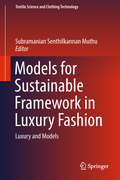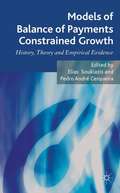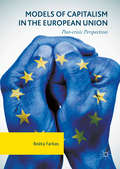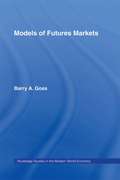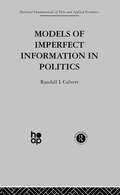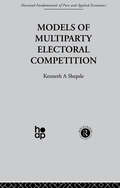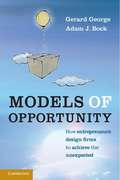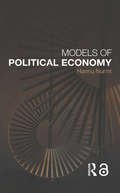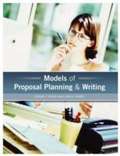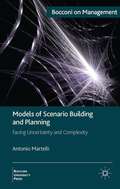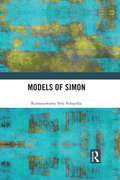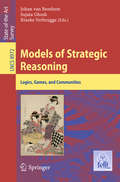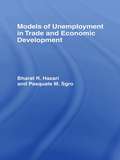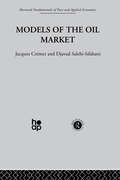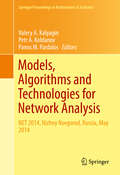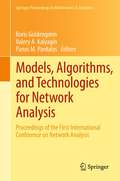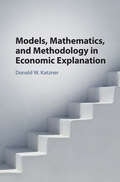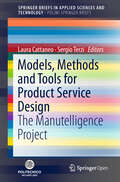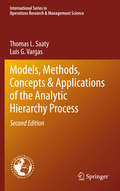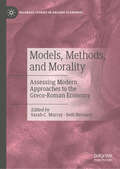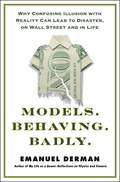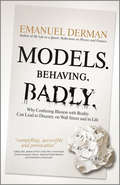- Table View
- List View
Models for Sustainable Framework in Luxury Fashion: Luxury And Models (Textile Science And Clothing Technology Ser.)
by Subramanian Senthilkannan MuthuThis book highlights the models developed to create a sustainable framework suitable for luxury in the textile sector and the innovative attempts in the luxury fashion and fabrics industry. The three chapters in this book discuss these issues by means of case studies and the future of such models.
Models of Balance of Payments Constrained Growth
by Elias Soukiazis Pedro A. CerqueiraThis book extends Thirlwall's model and adapts its implications to the current problems facing developed and emerging economies. In this context, this book combines theoretical models and empirical applications, unveiling new results and highlighting the importance of the balance of payments as a constraint to growth.
Models of Capitalism in the European Union
by Beáta FarkasThis book uses comparative economic analysis to provide a common conceptual framework for all current European Union member states. Based on empirical investigation, the author identifies the Nordic, North-western, Mediterranean, and Central and Eastern models of capitalism on the threshold of the 2008 global financial and economic crisis. The chapters also examine the resulting institutional responses to the crisis and the methods of crisis management adopted by each member state. The analysis reveals that the crisis has not triggered radical institutional change but, instead, highlighted deep institutional differences not between the old and new member states, but between the Nordic, North-western, Mediterranean, and Central and Eastern European countries. These institutional differences are so significant that they require the rethinking of European integration theory. Models of Capitalism in the European Union serves as a useful handbook for academics, advanced students, policy-makers and advisors who are interested in European economic issues.
Models of Endowment Management: King's College, Cambridge
by Elena Corsi Luis M. Viceira David Chambers Elroy DimsonOne of the University of Cambridge's Colleges evaluates different asset management options for its endowment fund. The King's College, one of the constituent colleges of the University of Cambridge in the UK, had most of its endowment invested in equity index funds. Its committee was to discuss whether they should overhaul their investment strategy. The college had three options. One was to invest in a new pooled fund created by the University, in which other colleges were also investing, another was to invest through a private multi-asset investment firm also used by other colleges, Partners Capital, or remain in index funds.
Models of Futures Markets (Routledge Studies in the Modern World Economy)
by Barry A. GossThis volume presents an entirely new analysis of the economics of futures markets, that will be of interest to both specialists in the area and the generalist economist seeking a new perspective. Through a combination of theoretical investigation and empirical application, three important themes are explored: the gains from futures trading and the efforts of emerging markets to reap these benefits; rationality and rival hypotheses of trader behaviour, such as noise trading; and the effect of regulatory tools on price formation.
Models of Imperfect Information in Politics (Fundamentals Of Pure And Applied Economics Ser. #Vol. 6)
by R. CalvertSurveys the models of political phenomena that incorporate imperfect information, concentrating on 'full-rationality' approaches as opposed to bounded rationality models.
Models of Multiparty Electoral Competition (Fundamentals Of Pure And Applied Economics Ser.)
by K. ShepsleKenneth A. Shepsle surveys the formal literature on multiparty electoral competition.
Models of Opportunity
by Gerard George Adam J. BockEntrepreneurship is changing. Technology and social networks create a smaller world, but widen the opportunity horizon. Today's entrepreneurs build organisations and create value in entirely new ways and with entirely new tools. Rather than just exploit new ideas, innovative entrepreneurs design organisations to make sense of unlikely opportunities. The time has come to overhaul what we know about entrepreneurship and business models. Models of Opportunity links scholarly research on business models and organisational design to the reality of building entrepreneurial firms. It provides actionable advice based on a deeper understanding of how business models function and change. The six insights extend corporate strategy and entrepreneurship in a completely new direction. Case studies of innovative companies across industries demonstrate how visionary entrepreneurs achieve unexpected results. The insights, tools and cases, provide a fresh perspective on emerging trends in entrepreneurship, organisational change and high-growth firms.
Models of Political Economy
by Hannu NurmiModels of Political Economy will introduce students to the basic methodology of political economics. It covers all core theories as well as new developments including: decision theory game theory mechanism design games of asymmetric information. Hannu Nurmi's text will prove to be invaluable to all students who wish to understand this increasingly technical field.
Models of Proposal Planning and Writing
by Jeremy T. Miner Lynn E. MinerGrantseeking has become an increasingly competitive process. Beginning grantwriters sometimes assemble a collection of facts and present that information to grantmakers, hoping to receive support. However, sponsors rarely award grant funding just because a grantseeker supports a specific cause or works for a specific organization. Grantseekers must persuade sponsors to invest in their projects and organization. Successful grantseekers know that persuasion, not information, attracts funding. Persuasive proposals present a seamless argument that stands the test of reason, addresses psychological concerns, and connects project ideas to the values of the sponsor.
Models of Scenario Building and Planning
by Antonio MartelliModels of Scenario Building and Planning offers a unique and innovative exploration of the scenario approach. Importance is given to analysis of the competitors' behaviour. If Models of Scenario Building Planning (MSBP) is there to serve strategy, it should consider (with the utmost care) the interaction between the company and its competitors as well as the possible consequences. For example, when we talk about the company environment, we should never forget that it is not made just by impersonal economic or social forces, but also, if not foremost, by specific human actors, the competing companies. This book also focuses on the analysis of risk and uncertainty in MSBP (avoiding, however, any excessive technicalities). Risk can be defined as the probability of non-success: MSBP should stress not only the advantages of a strategy based on the scenario which will eventually materialise, but also the losses incurred by betting on the wrong scenarios. This is a point which has not received adequate attention in the relevant literature. The importance of the link between scenarios and strategies is also explored, that is, how strategies can be worked out on the basis of the scenarios which have been built.
Models of Simon
by Kumaraswamy Vela VelupillaiHerbert Simon (1916-2001) is mostly celebrated for the theory of bounded rationality and satisficing. This book of essays on Models of Simon tackles these topics that the he broached in a professional career spanning more than 60 years. Expository material on the fundamental concepts he introduced are re-interpreted in terms of the theory of computability. This volume frames the behavioural issues of concern for economists, such as: hierarchy, causality, near-diagonal linear dynamical systems, discovery, the contrasts between the notion of heuristics, and the Church-Turing Thesis of Computability Theory. There is, consistently, an emphasis on the historical origins of the concepts Simon worked with, in emphasising Human Problem Solving and Decision Making – by rational individuals and institutions (like Organizations). The main feature of the results in the book are its emphasis on the procedural aspects of human problem solving, decision making and the remarkable way Simon harnessed many tools of mathematical logic, mathematics, cognitive sciences, economics and econometrics. This long-awaited volume is an important read for those who study economic theory and philosophy, microeconomics and political economy, as well as those interested in the great Herbert Simon’s work.
Models of Strategic Reasoning
by Rineke Verbrugge Johan Van Benthem Sujata GhoshStrategic behavior is the key to social interaction, from the ever-evolving world of living beings to the modern theatre of designed computational agents. Strategies can make or break participants' aspirations, whether they are selling a house, playing the stock market, or working toward a treaty that limits global warming. This book aims at understanding the phenomenon of strategic behavior in its proper width and depth. A number of experts have combined forces in order to create a comparative view of the different frameworks for strategic reasoning in social interactions that have been developed in game theory, computer science, logic, linguistics, philosophy, and cognitive and social sciences. The chapters are organized in three topic-based sections, namely reasoning about games; formal frameworks for strategies; and strategies in social situations. The book concludes with a discussion on the future of logical studies of strategies.
Models of Unemployment in Trade and Economic Development
by Bharat Hazari Pasquale SgroThe impact of increased levels of international trade on domestic labour markets is a key issue for policy makers in both developed and less developed countries. This book considers the most important current issues in this area in the context of models which examine the relationship between trade and employment. It is divided into three parts. The first deals with unemployment, decay and the `Dutch Disease': the second with structural adjustment, urban unemployment and protectionism; the last offers some variations on models of unemployment. In parts one and two the important insights are that minimum wages may cause decay rather than growth and that disaggregation of non-traded goods between urban and rural regions is of critical importance in structural adjustment, protectionism and the real exchange rate. In part three, segmented labour market theory is used to explain urban and disguised unemployment and the importance of proper agricultural policies for rural development is emphasised. Finally the impact of technology transfers on employment in both donor and recipient countries is explored.
Models of the Oil Market
by J. Crémer D. Salehi-IsfahaniEconomists have proposed a large variety of models of the oil market and this survey integrates them in a coherent framework.
Models, Algorithms and Technologies for Network Analysis
by Panos M. Pardalos Valery A. Kalyagin Petr A. KoldanovThe contributions in this volume cover a broad range of topics including maximum cliques, graph coloring, data mining, brain networks, Steiner forest, logistic and supply chain networks. Network algorithms and their applications to market graphs, manufacturing problems, internet networks and social networks are highlighted. The "Fourth International Conference in Network Analysis," held at the Higher School of Economics, Nizhny Novgorod in May 2014, initiated joint research between scientists, engineers and researchers from academia, industry and government; the major results of conference participants have been reviewed and collected in this Work. Researchers and students in mathematics, economics, statistics, computer science and engineering will find this collection a valuable resource filled with the latest research in network analysis.
Models, Algorithms, and Technologies for Network Analysis
by Panos M. Pardalos Boris Goldengorin Valery A. KalyaginNetwork Analysis has become a major research topic over the last several years. The broad range of applications that can be described and analyzed by means of a network is bringing together researchers, practitioners and other scientific communities from numerous fields such as Operations Research, Computer Science, Transportation, Energy, Social Sciences, and more. The remarkable diversity of fields that take advantage of Network Analysis makes the endeavor of gathering up-to-date material in a single compilation a useful, yet very difficult, task. The purpose of these proceedings is to overcome this difficulty by collecting the major results found by the participants of the "First International Conference in Network Analysis," held at The University of Florida, Gainesville, USA, from the 14th to the 16th of December 2011. The contributions of this conference not only come from different fields, but also cover a broad range of topics relevant to the theory and practice of network analysis, including the reliability of complex networks, software, theory, methodology and applications.
Models, Mathematics, and Methodology in Economic Explanation
by Donald W. KatznerThis book provides a practitioner's foundation for the process of explanatory model building, breaking down that process into five stages. Donald W. Katzner presents a concrete example with unquantified variable values to show how the five-stage procedure works. He describes what is involved in explanatory model building for those interested in this practice, while simultaneously providing a guide for those actually engaged in it. The combination of Katzner's focus on modeling and on mathematics, along with his focus on the explanatory performance of modeling, promises to become an important contribution to the field.
Models, Methods and Tools for Product Service Design: The Manutelligence Project (SpringerBriefs in Applied Sciences and Technology)
by Laura Cattaneo Sergio TerziThis open access book summarizes research being pursued within the Manutelligence project, the goal of which is to help enterprises develop smart, social and flexible products with high value added services. Manutelligence has improved Product and Service Design by developing suitable models and methods, and connecting them through a modular, collaborative and secure ICT Platform. The use of real data collected in real time by Internet of Things (IoT) technologies underpins the design of product-service systems and makes it possible to monitor them throughout their life cycle. Available data allows costs and sustainability issues to be more accurately measured and simulated in the form of Life Cycle Cost (LCC) and Life Cycle Assessment (LCA). Analysing data from IoT systems and sharing LCC and LCA information via the ICT Platform can help to accelerate the design of product-service systems, reduce costs and better understand customer needs. Industrial partners involved in Manutelligence provide a clear overview of the project’s outcomes, and demonstrate how its technological solutions can be used to improve the design of product-service systems and the management of product-service life cycles.
Models, Methods, Concepts & Applications of the Analytic Hierarchy Process
by Thomas L. Saaty Luis G. VargasThe Analytic Hierarchy Process (AHP) is a prominent and powerful tool for making decisions in situations involving multiple objectives. Models, Methods, Concepts and Applications of the Analytic Hierarchy Process, 2nd Edition applies the AHP in order to solve problems focused on the following three themes: economics, the social sciences, and the linking of measurement with human values. For economists, the AHP offers a substantially different approach to dealing with economic problems through ratio scales. Psychologists and political scientists can use the methodology to quantify and derive measurements for intangibles. Meanwhile researchers in the physical and engineering sciences can apply the AHP methods to help resolve the conflicts between hard measurement data and human values. Throughout the book, each of these topics is explored utilizing real life models and examples, relevant to problems in today's society. This new edition has been updated and includes five new chapters that includes discussions of the following: - The eigenvector and why it is necessary - A summary of ongoing research in the Middle East that brings together Israeli and Palestinian scholars to develop concessions from both parties - A look at the Medicare Crisis and how AHP can be used to understand the problems and help develop ideas to solve them.
Models, Methods, and Morality: Assessing Modern Approaches to the Greco-Roman Economy (Palgrave Studies in Ancient Economies)
by Sarah C. Murray Seth BernardThis edited volume presents a multi-perspectival inquiry into the models that have shaped the study of ancient economies in past decades. The contributions collected here respond to the prevailing tendency to measure ancient Mediterranean economies using methods and techniques designed for assessing the performance of modern economies, considering a range of approaches that might generate a more socially and morally attuned history of the ancient Mediterranean. The volume explores the challenges of quantification and critically examines the ideological assumptions implicit within the models usually applied to the study of ancient economic performance. The chapters advocate for more inclusive alternatives to traditional ideas of ‘growth’ that take factors such as social inequality, fairness, wellbeing and the relationship between humans and the natural environment into consideration. The book examines through a series of different questions the importance of querying the appropriateness of economic methods from an ethical or socially aware position. Rather than condemning older models, methods, and points of view for their inadequacies, this book focuses on leveraging the benefits from existing methods in economics and suggesting new frameworks to reach toward historical approaches that are both methodologically sophisticated and attuned to the moral, ethical, and political concerns of the twenty-first century. This book will be a valuable resource for interdisciplinary researchers in economics, economic history, ancient history and archaeology.
Models.Behaving.Badly.
by Emanuel DermanEmanuel Derman was a quantitative analyst (Quant) at Goldman Sachs, one of the financial engineers whose mathematical models usurped traders' intuition on Wall Street. The reliance traders put on such quantitative analysis was catastrophic for the economy, setting off the series of financial crises that began to erupt in 2007 with the mortgage crisis and from which we're still recovering. Here Derman looks at why people--bankers in particular--still put so much faith in these models, and why it's a terrible mistake to do so.Though financial models imitate the style of physics by using the language of mathematics, ultimately they deal with human beings. Their similarity confuses the fundamental difference between the aims and possible achievements of the phsyics world and that of the financial world. When we make a model involving human beings, we are trying to force the ugly stepsister's foot into Cinderella's pretty glass slipper. It doesn't fit without cutting off some of the essential parts. Physicists and economists have been too enthusiastic to recognize the limits of their equations in the sphere of human behavior--which of course is what economics is all about. Models.Behaving.Badly includes a personal account Derman's childhood encounter with failed models--the utopia of the kibbutz, his experience as a physicist on Wall Street, and a look at the models quants generated: the benefits they brought and the problems they caused. Derman takes a close look at what a model is, and then he highlights the differences between the success of modeling in physics and its relative failure in economics. Describing the collapse of the subprime mortgage CDO market in 2007, Derman urges us to stop relying on these models where possible, and offers suggestions for mending these models where they might still do some good. This is a fascinating, lyrical, and very human look behind the curtain at the intersection between mathematics and human nature.
Models.Behaving.Badly.
by Emanuel DermanEmanuel Derman was a quantitative analyst (Quant) at Goldman Sachs, one of the financial engineers whose mathematical models became crucial for Wall Street. The reliance investors put on such quantitative analysis was catastrophic for the economy, setting off the ongoing string of financial crises that began with the mortgage market in 2007 and continues through today. Here Derman looks at why people -- bankers in particular -- still put so much faith in these models, and why it's a terrible mistake to do so. Though financial models imitate the style of physics and employ the language of mathematics, ultimately they deal with human beings. There is a fundamental difference between the aims and potential achievements of physics and those of finance. In physics, theories aim for a description of reality; in finance, at best, models can shoot only for a simplistic and very limited approximation to it. When we make a model involving human beings, we are trying to force the ugly stepsister's foot into Cinderella's pretty glass slipper. It doesn't fit without cutting off some of the essential parts. Physicists and economists have been too enthusiastic to acknowledge the limits of their equations in the sphere of human behavior--which of course is what economics is all about. Models. Behaving. Badly includes a personal account of Derman's childhood encounters with failed models--the oppressions of apartheid and the utopia of the kibbutz. He describes his experience as a physicist on Wall Street, the models quants generated, the benefits they brought and the problems, practical and ethical, they caused. Derman takes a close look at what a model is, and then highlights the differences between the successes of modeling in physics and its failures in economics. Describing the collapse of the subprime mortgage CDO market in 2007, Derman urges us to stop the naïve reliance on these models, and offers suggestions for mending them. This is a fascinating, lyrical, and very human look behind the curtain at the intersection between mathematics and human nature.
Moden in der Hip-Hop-Szene: Eine ethnographische Studie über die Bedeutung und Dynamik von Modestrukturen (Erlebniswelten)
by Marco KrauseDiese Arbeit widmet sich dem Thema der szenespezifischen Moden. Der Kern dieser Forschungsarbeit besteht daraus, anhand einer ethnographischen Studie das szenespezifische Modephänomen im Kontext der Hip-Hop-Szene in seinen Strukturen abzubilden und dessen Facetten, Bedeutungen und Differenzierungen aufzudecken, um daran anknüpfend aufzuzeigen, welche Produkte beziehungsweise Produkteigenschaften die Szene-Mitglieder als Mode deklarieren und konsumieren und welchen Stellenwert dieses Phänomen innerhalb der Szene einnimmt. Die übergreifende Zielstellung bildet dabei die Generierung eines differenzierteren Betrachtungsansatzes des Modephänomens, welcher auf die Vergemeinschaftungsform der Hip-Hop-Szene bezogen ist und deren innere Strukturen und Facetten berücksichtigt.Der InhaltForschungsstand: Moden und Szenen • Forschungsstand: Hip-Hop-Szene • Forschungsdesign • Konsumrelevante Werte, Strukturen und Relationen in der Hip-Hop-Szene • Produktkonsum in der Hip-Hop-Szene • Moden in der Hip-Hop-SzeneDer AutorMarco Krause ist Soziologe mit Fokus auf den Bereich Konsumsoziologie und Consultant im Bereich Digital Intelligence.
Moderation, Präsentation und freie Rede: Darauf kommt es an (essentials)
by Matthias ReckzügelMatthias Reckzügel liefert eine praktische Sammlung kurz gefasster Tipps und Tricks für die erfolgreiche Durchführung von Moderationen und Präsentationen – von der Gestaltung von Foliensätzen, deren Präsentation bis hin zur Moderation von Vorträgen und Diskussionen sowie dem Umgang mit Störungen. Der Autor legt hier ein essential vor – eine Darstellung der wesentlichen Anforderungen zur kurzfristigen Umsetzung. Denn dies ist klar: Um eine Moderation oder Präsentation kommt heute kaum jemand herum! Es sind wichtige, nicht zu vernachlässigende und nicht zu unterschätzende Aufgaben in Studium und Beruf, zu denen die Leserinnen und Leser hier vielfältige Anregungen finden.
